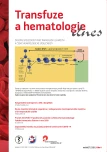Hypereosinophilia
Authors:
J. Novotný
Authors‘ workplace:
Oddělení klinické hematologie, FN Brno
Published in:
Transfuze Hematol. dnes,27, 2021, No. 4, p. 278-282.
Category:
Review/Educational Papers
doi:
https://doi.org/10.48095/cctahd2021278
Overview
Hypereosinophilia (HE) and hypereosinophilic syndrome (HES) represent very polymorphic syndromes often involving very difficult differential diagnosis. HES with serious end-organ damage must be treated promptly, especially in the presence of cardiac involvement. Parasitic infections are the most frequent cause of HE worldwide, yet they are rare in our latitudes. In developed countries, the main causes of HE include atopies (asthma, rhinitis, atopic dermatoses), drug reactions, autoagressive diseases and malignancies. In about 50% of patients with HES no specific cause is detected and these cases are termed idiopathic HES (iHES). High-dose corticosteroids represent the first-line therapy of severe HES, with promise being shown by biological treatments in the form of monoclonal antibodies (mepolizumab, reslizumab, benralizumab, alemtuzumab). Tyrosine-kinase inhibitors (TKI) are indicated in HE with proven aberrant tyrosine-kinase activity. Chronic eosinophilic leukaemia – not otherwise specified (CEL-NOS) requires a specific approach. Progress in research may in the near future help elucidate the specific cause of some iHES.
Keywords:
therapy – hypereosinophilia – diagnosis – hypereosinophilic syndrome – chronic eosinophilic leukaemia
Sources
1. Klion AD, Ackerman SJ, Bochner BS. Contributions of eosinophils to human health and disease. Ann Rev Pathol Mech. 2020; 15: 179–209.
2. Schwartz JT, Fulkerson PC. An approach to the evaluation of persistent hypereosinophilia in pediatric patients. Front Immunol. 2018; 9: 1944.
3. van Balkum M, Kluin-Nelemans H, van Hellemond JJ, et al. Hypereosinophilia: a diagnostic challenge. Netherlands J Med. 2018; 76: 431–436.
4. Wang SA. The diagnostic work-up of hypereosinophilia. Pathobiol. 2019; 86: 39–52.
5. Hu Z, Boddu PC, Loghavi S, et al. A multimodality work-up of patients with hypereosinophilia. Am J Hematol. 2018; 93: 1337–1346.
6. Fraisse M, Logre E, Mentec H, et al. Eosinophilia in critically ill COVID-19 patients: a French monocenter retrospective study. Crit Care. 2020; 24: 635.
7. Henes JC, Wirths S, Hellmich B. Differenzial Diagnose der Hypereosinophilie. Z Rheumatol. 2019; 78: 313–321.
8. Venode G, Figueiredo C, Almedia C, et al. Eosinophilic granulomatosis with polyangiitis (Churg-Strauss syndrome). Rev Assoc Med Bras. 2020; 66: 904–907.
9. Borges T, Silva S. IgG4-related disease: how to place it in the spectrum of immune-mediated and rheumatologic disorders? Modern Rheumatol. 2020; 30: 609–616.
10. Schirmer JH, Hoyer BF. HES und weitere rheumatische Erkrankungen mit Hypereosinophilie. Z Rheumatol. 2019; 78: 322–332.
11. Sanchez-Porro Valades P, Posada de la Plaz M, de Andres Copa P. Toxic oil syndrome: survival in the whole cohort between 1981 and 1995. J Clin Epidemiol. 2003; 56: 701–708.
12. Carreira PE, Montalvo MG, Kaufman LD, et al. Antiphospholipid antibodies in patients with EMS and TOS. J Rheumatol. 1997; 24: 69–72.
13. Fernandez-Becker NO, Raja S, Scarpignato C, et al. Eosinophilic esophagitis: updates on key unanswered questions. Ann N Y Acad Sci. 2020; 1481: 30–42.
14. Shulman LE. Diffuse fasciitis with eosinophilia: a new syndrome? Trans Assoc Am Physic. 1975; 88: 70–86.
15. Mango RL, Bugdayli K, Crowson C, et al. Baseline characteristics and long-term outcomes of eosinophilic fasciitis in 89 patients seen at a single center over 20 years. Int J Rheum Dis. 2020; 23: 233–239.
16. Isomoto K, Baba T, Sekine A, et al. Promising effects of benralizumab on chronic eosinophilic pneumonia. Int Med. 2020; 59: 1195–1198.
17. Mattis DV, Wang SA, Lu CM. Contemporary classification and diagnostic evaluation of HE. Am J Clin Pathol. 2020; 154: 305–318.
18.Shomali W, Gotlib J. WHO-defined eosinophilic disorders: 2019 update on diagnosis, risk stratification, and management. Am J Hematol. 2019; 94: 1149–1166.
19. Richardson AI, Skikne BS, Woodroof J. CML, BCR/ABL 1 positive in accelerated phase with marked eosinophilia with eosinophil atypia. Br J Haematol. 2020; 188: 599.
20. Rigoni R, Fontana E, Dobbs K, et al. Cutaneous barrier leakage nad gut inflammation drive skin disease in Omenn syndrome. J Allergy Clin Immunol. 2020; 146: 1165–1179.
21. Kluin-Nelemans HC, Reiter A, Illerhaus A, et al. Prognostic impact of eosinophils in mastocytosis: analysis of 2350 patients collected in the ECNM registry. Leukemia. 2020; 34: 1090–1101.
22. Dispenza MC, Bochner BS. Diagnosis and novel approaches to the treatment of HES. Curr Hematol Malignancy Rep. 2018; 13: 191–201.
23. Iurlo A, Cattaneo D, Gianelli U. HES in the precision medicine era: clinical, molecular aspects and therapeutic approaches (targeted therapies). Expert Rev Hematol. 2019; 12: 1077–1088.
24. Helbig G. Imatinib for the treatment of HES. Expert Rev Clin Immunol. 2018; 14: 163–170.
25. Legrand F, Cao Y, Wechsler JB, et al. Siglec 8 in patients with eosinophilic disorders: receptor expression and targeting using chimeric antibodies. J Allergy Clin Immunol. 2019; 143: 2227–2237.
26. Brychtová Y, Doubek M. Myeloidní a lymfoidní neoplazie s eozinofilií. In: Doubek M, Mayer J. Léčebné postupy v hematologii 2020 Doporučení České hematologické společnosti České lékařské společnosti Jana Evangelisty Purkyně. 1. Vyd. Brno, Česká hematologická společnost ČLS JEP, 2020; 173–183.
26. Shomali W, Gotlib J. WHO-defined eosinophilic disorders: 2019 update on diagnosis, risk stratification, and management. Am J Hematol. 2019; 94: 1149–1167.
Labels
Haematology Internal medicine Clinical oncologyArticle was published in
Transfusion and Haematology Today

2021 Issue 4
Most read in this issue
- Hypereosinophilia
- Congenital neutropenia in children and adults
- Neuro-immune interactions in the oncogenesis of multiple myeloma and their therapeutical relevance
- West Nile fever in the background of the COVID-19 pandemic
